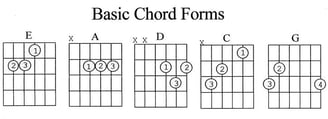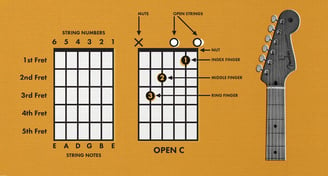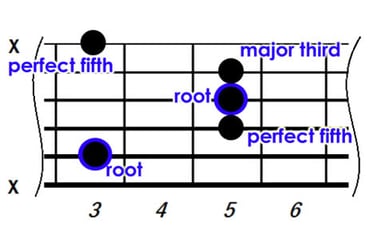
5 Must-Know guitar chords
6 min read
5 must-know guitar chords
Welcome to the world of guitar playing! As a beginner, it's key to start with the basics of guitar chords on an acoustic guitar. I'm excited to share with you the fundamentals of guitar chords that will help you master acoustic guitar basics.
With these essential guitar chords, you'll be able to play your favorite songs and start jamming with friends on your acoustic guitar. I'll cover the basics of guitar chords, including how to read chord diagrams and proper hand positioning for playing guitar chords on an acoustic guitar.
Whether you're a complete beginner or just looking to improve your skills on the acoustic guitar, this article is perfect for you. I'll guide you through the process of learning guitar chords and playing your favorite songs on an acoustic guitar.
Introduction to Guitar Chords
Learning guitar chords can seem intimidating at first, but with practice and patience, you'll be playing like a pro on your acoustic guitar in no time. I'll provide you with the necessary tools and tips to help you master guitar chords and improve your skills on the acoustic guitar.
Key Takeaways
Learn the basics of guitar chords on an acoustic guitar
Understand how to read chord diagrams for guitar chords
Master proper hand positioning for playing guitar chords on an acoustic guitar
Start playing your favorite songs with essential guitar chords on an acoustic guitar
Improve your skills with practice and patience on the acoustic guitar
Understanding Basic Guitar Chord Theory
Learning guitar chord theory is key for playing your favorite songs. It teaches you how chords are made and how to play them. Let's cover the basics, like the root note, major and minor chords, and reading chord diagrams.
For beginners, knowing what makes up a chord is vital. This includes the root note and whether it's major or minor. These parts help you learn chords fast and get better at playing the guitar.
What Makes Up a Guitar Chord
A guitar chord has three main parts: the root note, the major or minor quality, and the chord shape. The root note is the chord's base. The major or minor quality affects the chord's sound. The chord shape shows where to place your fingers on the fretboard.
Reading Chord Diagrams
Reading chord diagrams is a must for guitar players. These diagrams show how to place your fingers for a chord. Learning to read them helps you pick up new chords quickly and boosts your skills.
When looking at chord diagrams, notice the root note, major or minor quality, and chord shape. Knowing these helps you play chords accurately and improves your skills. With practice, you'll soon play your favorite songs using beginner chords and theory.
The Em Chord: Your Gateway to Guitar Mastery
Exploring guitar playing, I found the Em chord is key to guitar mastery. It fits in many music styles, from rock to folk. It's perfect for beginners. To play it, you need to place your fingers on the right frets and strings. It might be tough at first, but with practice, you'll master it.
Learning the Em chord opens up many song options. You can play simple tunes or complex ones. Famous songs like "Hotel California" by the Eagles and "Stairway to Heaven" by Led Zeppelin use the Em chord.
To improve your guitar mastery, practice the Em chord often. Start by playing it in different ways, like in a progression or alone. Try different strumming patterns and techniques to spice up your playing. With hard work and dedication, you'll play the Em chord smoothly and confidently. This will help you grow in guitar mastery.
Here are some tips for playing the Em chord:
Place your fingers on the correct frets and strings
Use a metronome to practice playing in time
Try different strumming patterns and techniques
By following these tips and practicing often, you'll get closer to guitar mastery. You'll open up a world of musical possibilities.
Essential Acoustic Guitar Chords for Beginners
Learning acoustic guitar basics can feel daunting at first. But, mastering a few key chords can change everything. We'll look at the basic chords beginners need to play their favorite tunes. Learning these chords is the first step to making your own music.
Practicing regularly and focusing on finger placement and strumming is key. Here are some essential chords to start with:
The G Major Chord: a versatile chord used in many popular songs
The C Major Chord: a fundamental chord that's easy to learn and play
The D Major Chord: a chord that adds depth and complexity to your music
The A Major Chord: a chord that's commonly used in folk and rock music
Learning these chords will help you become a skilled acoustic guitar player. Remember to practice often and enjoy the journey. With hard work and dedication, you'll soon be playing your favorite songs.
As you grow as a musician, you'll see that acoustic guitar basics are the base of all skills. So, take the time to learn these essential chords. You'll be amazed at how fast you can improve and grow.
Common Chord Transitions and Strumming Patterns
Exploring guitar playing has shown me the value of mastering chord transitions and guitar strumming patterns. These skills are key to adding depth and variety to my music. I've been practicing different strumming patterns, like downstrokes, upstrokes, and combinations.
Some important guitar strumming patterns I've been focusing on include:
Downstrokes: emphasizing the downbeat for a strong rhythm
Upstrokes: emphasizing the upbeat for a lighter feel
Combination patterns: mixing downstrokes and upstrokes for a complex rhythm
I've also been working on smooth chord transitions. This involves using pivot chords and creating unique strumming patterns. By doing this, I'm able to make my music sound more polished and professional.
Conclusion: Your Journey to Guitar Excellence Starts Here
Your guitar journey has just begun, and the possibilities are endless. You've learned the 5 must-know guitar chords and skills in this article. Now, you're on your way to becoming a skilled guitar player.
Remember, consistent practice is key to guitar excellence. Make sure to practice regularly. This will help you improve your skills.
As you play and explore new techniques, don't be afraid to try new things. The guitar is very versatile. The more you experiment, the more you'll learn about your musical abilities.
Keep an open mind and enjoy the learning process. It's all part of the adventure. Don't forget to have fun with your guitar.
Music has the power to soothe the soul, ignite creativity, and bring people together. Embrace this spirit as you continue on your path to guitar excellence. Let the music guide you.
FAQ
What are the essential guitar chords for beginners to learn?
Beginners should start with G major, C major, D major, A major, and E minor (Em) chords. These chords are key for playing many popular songs and styles.
How do I read a chord diagram?
Chord diagrams show how to place your fingers on the guitar strings. The vertical lines are the strings, and the horizontal lines are the frets. Circles mean press down on those strings, and the number at the top shows the fret number.
What is the proper hand positioning
for playing guitar chords
Your fretting hand should curve, with fingers pressing down near the frets. Your strumming hand should be relaxed, moving smoothly to strum the strings.
How can I transition smoothly between different guitar chords?
To play smoothly, start with simple chord transitions like G major to C major. Focus on quick, accurate finger movements. Try different strumming patterns to make chord changes smooth.
What are some common guitar strumming patterns for beginners?
Beginners often start with the down-up strum, alternating down-up, or steady down strum. Begin with a simple down-up pattern and add complexity as you get better.
How can I take my guitar playing to the next level?
Keep practicing, try new chords and techniques, and get feedback from others. Mastering chord changes and strumming will help you explore more advanced styles.








Melody
Passionate about guitars, music history, and learning.
Learn
© 2024. All rights reserved.